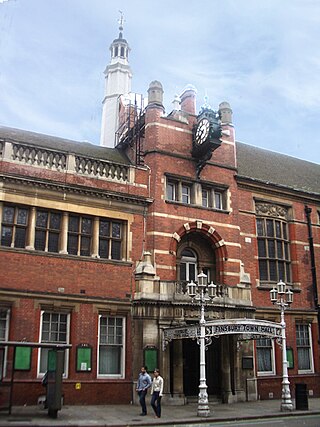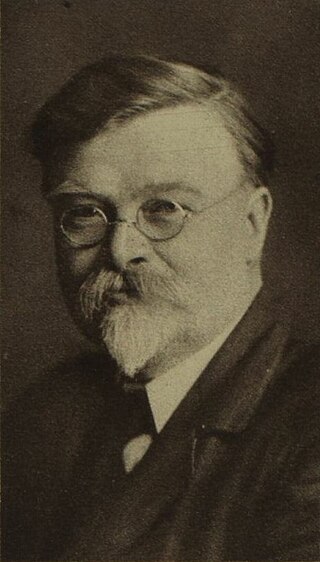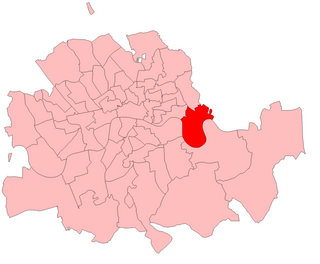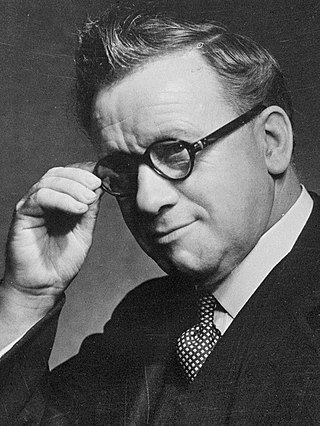Metropolitan borough councils
The first elections for which the Municipal Reform Party stood were those to Metropolitan Borough councils, on 1 November 1906. The campaign was very successful, with Municipal Reformers winning control of twenty-two of twenty-eight councils. Of the remaining six councils, three had majorities of Municipal Reform-backed ratepayers or independents. Progressives held only three of twelve boroughs they previously controlled, while the Labour party lost its only borough, Woolwich, to the new party. [4]
1906 was to prove a high point for Municipal Reform in the boroughs. They lost some ground in 1909 and 1912, but in 1919 they suffered major reverses at the hands of a resurgent Labour Party. Labour and Municipal Reform each had control of 11 boroughs after the election, although Municipal Reformers were able to have a share of power in the remaining boroughs by forming anti-Labour alliances with the remnants of the Progressive organisation. This anti-Labour strategy led to them returning to power in a number of boroughs at the next election in 1922 and by 1931 they controlled 18 boroughs, with six others controlled by allied parties or coalitions. From that point on the party's vote and share of seats declined at each election. The last election contested by the Municipal Reform Party was in 1945, when they held six boroughs. At the following election in 1949, official Conservative Party candidates stood for the first time. [5]
London County Council
Following their success in the 1906 borough elections, the Municipal Reform Party published a manifesto for the 1907 London County Council election. The party's policies included: tight controls on financial expenditure, proper auditing of municipal accounts, creation of a traffic board to co-ordinate transport in the capital, abandonment of the Progressive Party's plan to supply electricity in favour of provision by private enterprise and an education policy favouring denominational schools. [6]
The election was held on 2 March 1907, and the party's campaign was highly successful, with Municipal Reformers taking power from the Progressives. The party was to hold power until 1934 when the Labour Party under Herbert Morrison gained control. [7]
From 1934 to 1946 the Municipal Reform Party formed the opposition on the county council. The party effectively ceased to exist in 1946, when no Municipal Reform Party candidates were nominated for the county council election, and Conservative candidates appeared in their place for the first time.

The Metropolitan Borough of Bermondsey was a Metropolitan borough in the County of London, created in 1900 by the London Government Act 1899. It was abolished and its area became part of the London Borough of Southwark in 1965.

The Metropolitan Borough of Finsbury was a metropolitan borough within the County of London from 1900 to 1965, when it was amalgamated with the Metropolitan Borough of Islington to form the London Borough of Islington.

The Metropolitan Borough of Greenwich was a metropolitan borough in the County of London between 1900 and 1965. It bordered the boroughs of Woolwich, Lewisham and Deptford and, across the River Thames, the borough of Poplar and the County Borough of West Ham in Essex. Within the area of the borough were the Royal Naval College, the Royal Observatory and Greenwich Park.

Battersea was a civil parish and metropolitan borough in the County of London, England. In 1965, the borough was abolished and its area combined with parts of the Metropolitan Borough of Wandsworth to form the London Borough of Wandsworth. The borough was administered from Battersea Town Hall on Lavender Hill. That building is now Battersea Arts Centre.

The Metropolitan Borough of Hackney was a metropolitan borough of the County of London from 1900 to 1965. Its area became part of the London Borough of Hackney.

Bethnal Green was a civil parish and a metropolitan borough in the East End of London, England.

East Ham was a local government district in the far south west of Essex from 1878 to 1965. It extended from Wanstead Flats in the north to the River Thames in the south and from Green Street in the west to Barking Creek in the east. It was part of the London postal district and Metropolitan Police District.

Alfred Henry Scott was a British Liberal politician.
Henry Edwin Goodrich was a British Labour politician.
An election to the County Council of London took place on 2 March 1907. The council was elected by First Past the Post with each elector having two votes in the two-member seats. For the first time, the Progressive Party lost control of the council, being defeated by the recently formed Municipal Reform Party.
An election to the County Council of London took place on 5 March 1910. It was the eighth triennial election of the whole Council. The size of the council was 118 councillors and 19 aldermen. The councillors were elected for electoral divisions corresponding to the parliamentary constituencies that had been created by the Representation of the People Act 1884. There were 57 dual member constituencies and one four member constituency. The council was elected by First Past the Post with each elector having two votes in the dual member seats.

An election to the County Council of London took place on 5 March 1913. It was the ninth triennial election of the whole Council. The size of the council was 118 councillors and 19 aldermen. The councillors were elected for electoral divisions corresponding to the parliamentary constituencies that had been created by the Representation of the People Act 1884. There were 57 dual member constituencies and one four member constituency. The council was elected by First Past the Post with each elector having two votes in the dual member seats. Unlike for parliamentary elections, women qualified as electors for these elections on exactly the same basis as men. Women were also permitted to stand as candidates for election.

An election to the County Council of London took place on 2 March 1922. It was the eleventh triennial election of the whole council. There were sixty dual member constituencies and one four member constituency, making a total of 124 seats. The council was elected by First Past the Post with each elector having two votes in the dual member seats.

Sir George Hopwood Hume was a British Conservative politician and leader of the London County Council.

George Alexander Hardy was an English businessman and Liberal Party politician who served for many years as a councillor in South London, and briefly as a Member of Parliament (MP) for the Stowmarket division of Suffolk.

Local government elections took place in London on 1 November 1906.

The Poplar by-election was a Parliamentary by-election held on 19 February 1914. The constituency returned one Member of Parliament (MP) to the House of Commons of the United Kingdom, elected by the first past the post voting system.

The Haggerston by-election was a Parliamentary by-election held on 1 August 1908. The constituency returned one Member of Parliament (MP) to the House of Commons of the United Kingdom, elected by the first past the post voting system.

An election to the County Council of London took place on 4 March 1937. The council was elected by First Past the Post with each elector having two votes in the two-member seats. The Labour Party made gains, increasing their majority over the Municipal Reform Party.

An election to the County Council of London took place on 8 March 1934. The council was elected by First Past the Post with each elector having two votes in the two-member seats. The Labour Party made large gains from the Municipal Reform Party, and for the first time won control of the council..
This page is based on this
Wikipedia article Text is available under the
CC BY-SA 4.0 license; additional terms may apply.
Images, videos and audio are available under their respective licenses.















